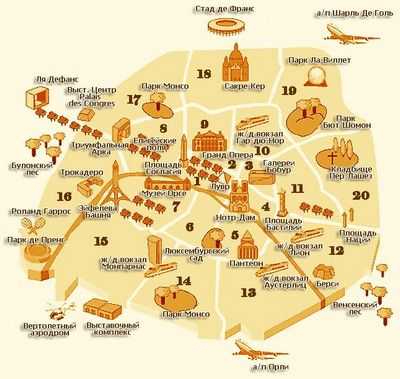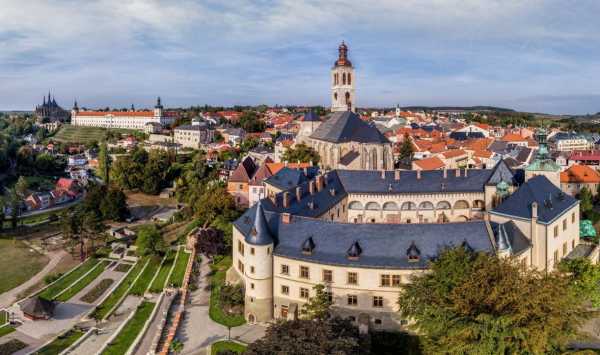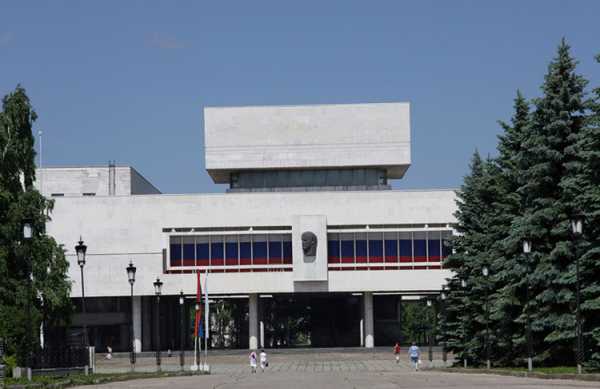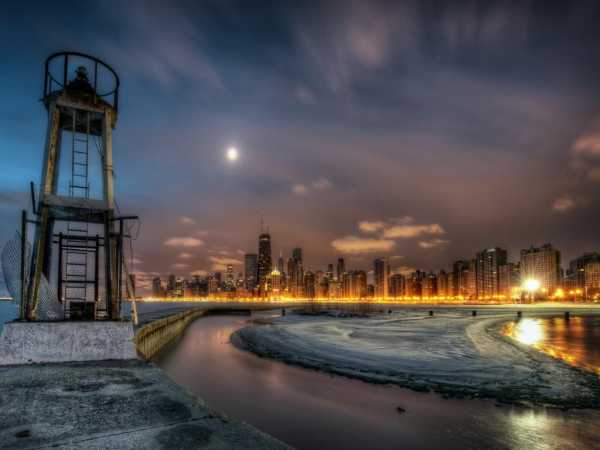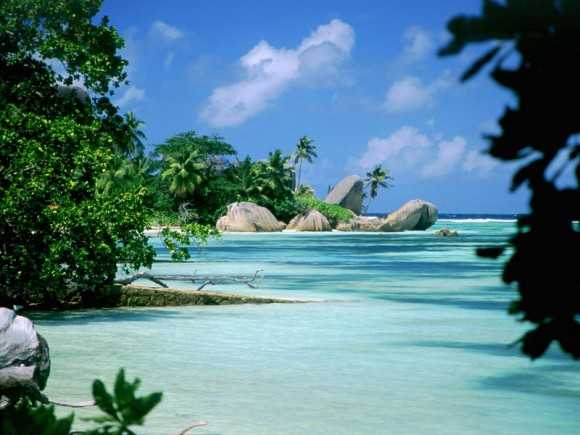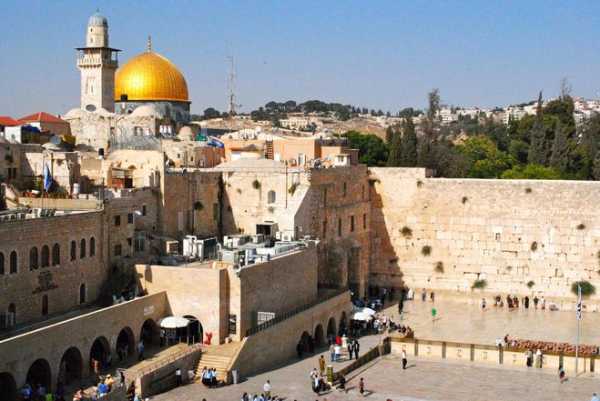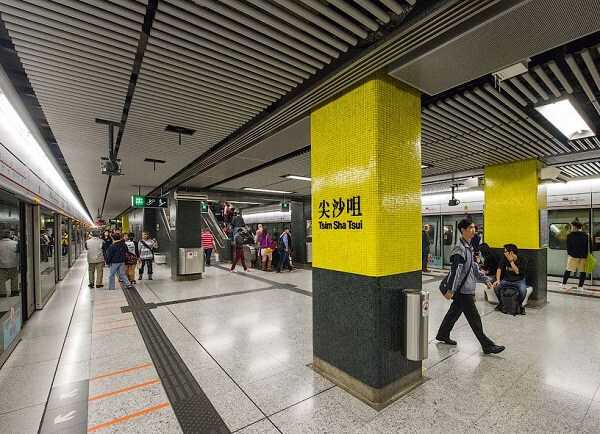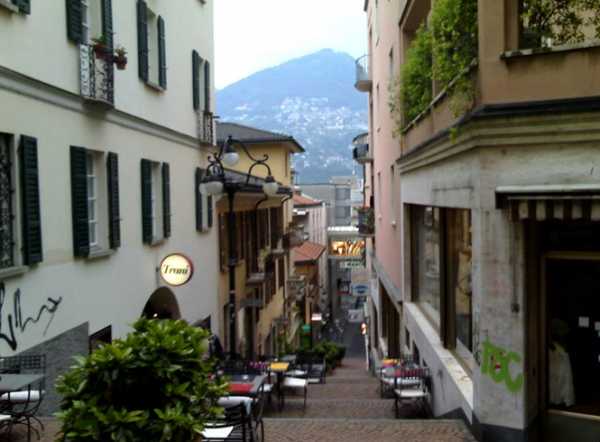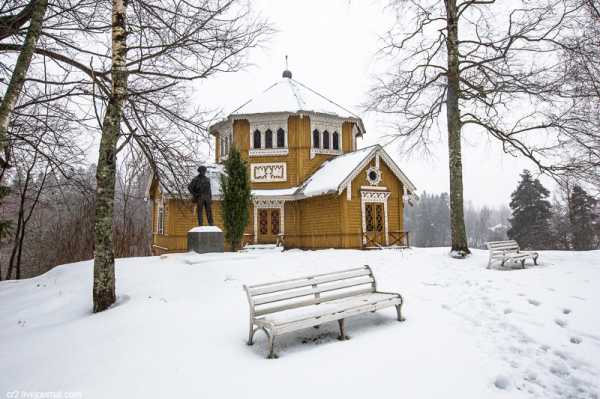 |
 |
 |
 |
|
Составь рассказ "Мой родной город".. Желательно про Нижний Новгород!!! Достопримечательности нижнего новгорода на английском языке с переводомТема Нижний Новгород на английском языке: достопримечательности, рассказ о городеНижний Новгород — город множества достопримечательностей. Nizhny Novgorod Kremlin – Нижегородский Кремль
The Kremlin is the center and the heart of the city. It’s the place where the history of Nizhny Novgorod started.Nizhny Novgorod Kremlin includes 5 square towers with the gates and 8 round ones.The city authorities, the region governor administration and the legislation authorities are situated inside the Kremlin walls. Moreover, there are religion and cultural sights such as Mikhaylo-Arkhangelsky Cathedral, Eternal Flame and museums. Nizhny Novgorod Fair– Нижегородская ярмарка
Founded ages ago now Nizhny Novgorod Fair is both a great historical and architectural tourist attraction and a famous exhibition center.Nizhny Novgorod Fair has a great history. Actually it was a market place but after renovating the fair has become a superb modern exhibition complex that now welcomes different international events, fairs, and conventions. Nizhny Novgorod State Art Museum Rukavishnikov Mansion– Нижегородский государственный художественный музей
The Nizhny Novgorod State Art Museum is one of the oldest museums in Russia. Being founded in 1896 as «The City Art and Historical Museum» it has gained a great history and now has got a diverse and rich collection of paintings of different trend and genre. There are masterpieces both of Russian and European painters. Rukavishnikov Mansion – Усадьба Рукавишниковых
This exhibition space is located inside a 19th-century mansion once belonging to the Rukavishnikov merchant family. There you can wander through the rooms on your own or join one of the hourly 40-minute excursions in Russian and English. Furniture and the interior are illustrious. Chkalov Staircase – Чкаловская лестница
The Chkalov Staircase is a great and monumental erection built in the Soviet era. The construction of the staircase cost an immense sum at the time – almost 8 million rubles and was built by German prisoners of the war. The staircase derives its name from pilot Valery Chkalov. He was the first man who flew from Moscow to Vancouver through the North Pole in 1937. There is a monument to Chkalov at the top of the stairs. Staircase numbers at about 1,500 stairs that connect the river embankment with the city center.
150slov.com Рассказ о Новгороде на английском (тема, топик с переводом)Novgorod is one of the ancient cities in Russian Federation. There is a great number of monuments, museums and other places of interest on the territory of Novgorod. Novgorod was founded in 859 AD on the Volkhov River not far from the Ilmen Lake. It is considered that the history of Russian statehood has begun from this place. The city history is closely connected with the main periods of development and life of Russia. In 862 this city became the first capital of Rus but later the capital was moved to Kiev by Vladimir the Great. In those days Novgorod was playing a key role in expanding of culture and literacy in Russia. Almost all citizens of the city were educated. Novgorod was not only a cultural center but it was also a reliable fortress protecting Russian borders. During Tatar and Mongol invasion Novgorod didn’t suffer thereby it kept its unique ancient Russian architecture which is now attracting tourists from all over the world.
In the 21th century Novgorod is an important port and railway hub. The city has modern infrastructure: hotels, schools, universities, restaurants, parks and shopping malls. There is an airport in the city. The city is attractive for the tourists who would like to visit monuments of ancient Russia. It is famous for its Kremlin, Monument devoted to Millennium of Russia, orthodox churches, archaeological sites. The Kremlin was first mentioned in the chronicle in 1044. It is situated on the hill over the Volkhov River. At first the Kremlin was wooden and it has burnt down several times. The Kremlin was built of stone in 1430. There are 3 churches and 9 towers within the Kremlin. Construction of Saint Sophia’s cathedral started in 1045 on the Kremlin territory. The Cathedral was constructed in the byzantine style and had 6 domes. Nowadays it is the main Orthodox Church in Novgorod. Millennium of Russia monument was built in the city in 1862. It represents a giant bell with the bas-reliefs showing various details of Russian history. At the top of the monument there is a woman down on her knees representing Russia and an angel with a cross in his hand. Nowadays population of Novgorod is equal to approximately 220 000 people. Chemical, food, wood-working, mechanical engineering, metal processing and electrical industries are successfully developed in Novgorod. The city is one of Russian touristic centres. They say that to know Russia one should visit Novgorod. Do visit it as soon as you have such a chance. Перевод Новгород является одним из древних городов в Российской Федерации. На территории находится большое количество памятников, музеев и других достопримечательностей. Город был основан около реки Волхов, рядом с озером Ильмень в 859 г. Считается, что с этого места началась история российского государства. История города связана с основными периодами развития и жизни России. В 862 году Новгород стал первой столицей Руси, которая позже была перенесена в Киев Владимиром Великим. В те времена Новгород играл огромную роль в распространении культуры и грамотности. Практически все население города было образованным. Он был не только культурным центром, но и надежной крепостью, защищавшей русские рубежи. Во время татаро-монгольского ига Новгород не пострадал от монгольского нашествия, тем самым сохранил уникальную древнерусскую архитектуру, которая привлекает туристов со всего мира.
В 21 веке Новгород является важным портом и железнодорожным узлом. Город обладает современной инфраструктурой: гостиницы, школы, университеты, рестораны, парки и торговые центры. В городе расположен аэропорт. Город привлекателен для туристов, которые желают познакомиться с памятниками Древней Руси. На территории Великого Новгорода размещён кремль, знаменитый памятник посвящённый Тысячелетию Руси, православные храмы, места археологических раскопок. Кремль впервые упоминается в летописи в 1044 году. Он расположен на холме над рекой Волхов. Первоначально кремль был деревянным и горел несколько раз. Каменный кремль был построен в 1430 годах. В кремле есть 3 храма, 9 башен В 1045 году началось возведение Софийского собора на территории кремля. Собор выполнен в византийском стиле и имеет 6 куполов. Он является главным православным храмом. Памятник Тысячелетия Руси построен в Новгороде в 1862 году. Он представляет собой гигантский колокол с барельефами, отражающими разные фрагменты российской истории. На вершине монумента изображена коленопреклоненная женщина, олицетворяющая Россию и ангел с крестом в руке. В настоящее время численность населения примерно равна 220 000 человек. В Новгороде развивается химическая, пищевая, деревообрабатывающая, машиностроительная и металлообрабатывающая, электротехническая промышленность. Город является одним из туристических центров России. Говорят, что для того, чтобы узнать Россию, нужно побывать в Новгороде. Обязательно сделайте это, как только у вас появится такая возможность. Материал подготовлен нашими репетиторами английского по скайпу. Первый урок бесплатный в рамках 30 минут. online-teacher.ru Презентация по английскому языку "Nizhniy Novgorod"Описание презентации по отдельным слайдам: 1 слайд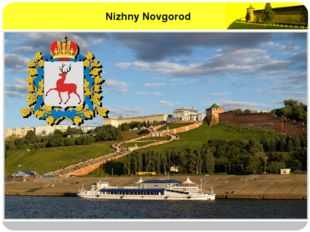 Описание слайда: Описание слайда: Nizhny Novgorod 2 слайд Описание слайда: Описание слайда: ABOUT THE CITY Nizhny Novgorod is one of the most beautiful and ancient Russian towns, beautifully located on Dyatlovy hills at the confluence of two big rivers, the Volga and the Oka. The Nizhny Novgorod of today is a big industrial, scientific and cultural center. 3 слайд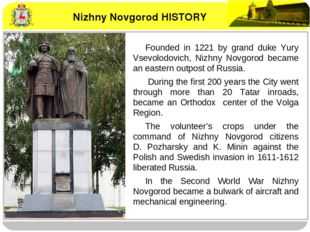 Описание слайда: Описание слайда: Nizhny Novgorod HISTORY Founded in 1221 by grand duke Yury Vsevolodovich, Nizhny Novgorod became an eastern outpost of Russia. During the first 200 years the City went through more than 20 Tatar inroads, became an Orthodox center of the Volga Region. The volunteer’s crops under the command of Nizhny Novgorod citizens D. Pozharsky and K. Minin against the Polish and Swedish invasion in 1611-1612 liberated Russia. In the Second World War Nizhny Novgorod became a bulwark of aircraft and mechanical engineering. 4 слайд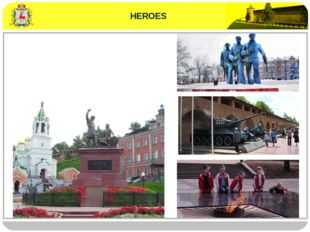 Описание слайда: Описание слайда: HEROES 5 слайд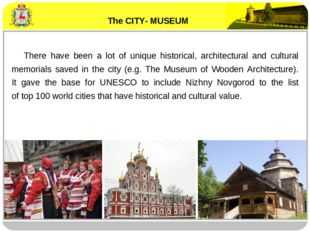 Описание слайда: Описание слайда: The CITY- MUSEUM There have been There have been a lot of unique historical, architectural and cultural memorials saved in the city (e.g. The Museum of Wooden Architecture). It gave the base for UNESCO to include Nizhny Novgorod to the list of top 100 world cities that have historical and cultural value. 6 слайд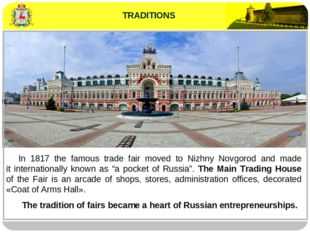 Описание слайда: Описание слайда: TRADITIONS In 1817 the famous trade fair moved to Nizhny Novgorod and made it internationally known as “a pocket of Russia”. The Main Trading House of the Fair is an arcade of shops, stores, administration offices, decorated «Coat of Arms Hall». The tradition of fairs became a heart of Russian entrepreneurships. 7 слайд Описание слайда: Описание слайда: CULTURE and ART There are many places to visit in Nizhny Novgorod: museums, exhibitions, concert halls, theaters, cinemas, parks, clubs and others. 8 слайд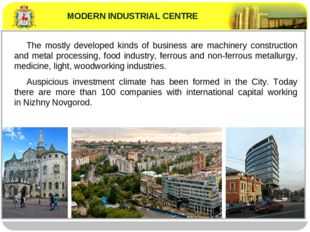 Описание слайда: Описание слайда: MODERN INDUSTRIAL CENTRE The mostly developed kinds of business are machinery construction and metal processing, food industry, ferrous and non-ferrous metallurgy, medicine, light, woodworking industries. Auspicious investment climate has been formed in the City. Today there are more than 100 companies with international capital working in Nizhny Novgorod. 9 слайд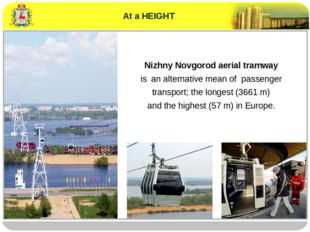 Описание слайда: Описание слайда: At a HEIGHT Nizhny Novgorod aerial tramway is an alternative mean of passenger transport; the longest (3661 m) and the highest (57 m) in Europe. Найдите материал к любому уроку,указав свой предмет (категорию), класс, учебник и тему: Выберите категорию: Все категорииАлгебраАнглийский языкАстрономияБиологияВсемирная историяВсеобщая историяГеографияГеометрияДиректору, завучуДоп. образованиеДошкольное образованиеДругоеДругойЕстествознаниеИЗО, МХКИзобразительное искусствоИностранные языкиИнформатикаИскусствоИспанский языкИсторияИстория РоссииИстория Средних вековИтальянский языкКлассному руководителюКультурологияЛитератураЛитературное чтениеЛогопедияМатематикаМировая художественная культураМузыкаМХКНачальные классыНемецкий языкОБЖОбществознаниеОкружающий мирОсновы безопасности жизнедеятельностиПриродоведениеРелигиоведениеРисованиеРусский языкСоциальному педагогуТехнологияУкраинский языкФизикаФизическая культураФилософияФинский языкФранцузский языкХимияЧерчениеЧтениеШкольному психологуЭкология Выберите класс: Все классыДошкольники1 класс2 класс3 класс4 класс5 класс6 класс7 класс8 класс9 класс10 класс11 класс Выберите учебник: Все учебники Выберите тему: Все темы также Вы можете выбрать тип материала: Общая информация Номер материала: ДБ-260313 Похожие материалы Оставьте свой комментарийinfourok.ru Топик "My Native town Nizhny Novgorod" (материал для урока английского языка) - К уроку - Иностранные языкиMy Native town Nizhny Novgorod Everybody believes that his home town is an important place. Many interesting things can be said about Nizhny Novgorod its attractions and residents. To begin with, Nizhny Novgorod is rather old. Over seven hundred years have passed since ancient tribes built a fortress on a high bank of the Oka River, where it joins the Volga. So, the city was founded in 1221, by Great Russian Prince Jury, a son of Vsevolod. Now it is one of the most beautiful Russian cities and a city of great national importance. It has a great population and is the third largest city in Russia. Nizhny Novgorod has a rich history. In 1612 K. Minin and D. Pozharsky organized here people’s volunteer troops and made our Motherland free from Polish invaders. Nizhny Novgorod is the birthplace of Kulibin, a self-taught mechanical engineer, Lobachevsky, a mathematician, Melnikov-Pechorsky and M.Gorky, the writers. In 1932 the town was renamed Gorky, in honour and memory of the Great Russian writer, and in 1991 it got the name of Nizhny Novgorod again. Nizhny Novgorod remembers Peter the great, Pushkin, Shevchenko, Chehov, Shalyapin, Saharov, who visited our city. In the past Nizhny Novgorod was an important commercial centre and the city of powerful merchant families. All Russian Trade Fair was held in Nizhny Novgorod for many years. Nizhny Novgorod is well-known as a great industrial and transport centre of our country. There are many big factories in it. It is famous for the automobile plant and its cars. Shipbuilding is also developed in our city, a lot of ships for the Volga and other rivers are built here. In Nizhny Novgorod railroads, waterways and airlines meet. In 1985 a regular Metro traffic was added to this transport network. My native town is a cultural and scientific centre as well. There are many theatres: the opera House, the Drama Theatre, the Puppet show, the Theatre of Young spectators, the Theatre of Comedy. You can also visit a lot of museums, the Art Gallery, cinemas and libraries. The city is famous for its historical places. The most interesting are: Bolshaya Pokrovskaya Street with its beautiful buildings and the Kremlin with its ancient towers. A lot of gardens and parks make our city green and attractive. And the embankment of the Volga River is a fine place for a walk and a good rest. My native town is beautiful in any season. I love it and I am proud to be its citizen. pedsovet.su Нижегородский кремль (на английском языке)THE KREMLIN OF NIZHNY NOVGOROD
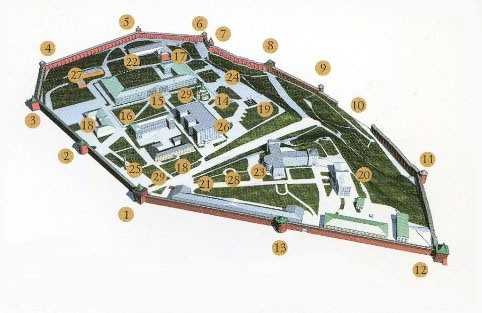 Towers: 1. Dmitrievskaya. 2. Kladovaya (Storage). 3. Nikolskaya. 4. Koromyslova (Yoke). 5. Tainitskaya (Secret). 6. Severnaya (North). 7. Chasovaya (Clock). 8. Ivanovskaya. 9. Belaya (White). 10. Zachatievskaya. 11. Borisoglebskaya. 12. Georgievskaya. 13. Porokhovaya (Gunpowder). 14. Archangel Cathedral. 15. A work-place's building. (Cadet Corps). 16. The vice-governor's houses. 17. The building of the Kremlin Police Unite. 18. The garnison baracks. 19. The obelisk in honour of Kozma Minin and Dmitry Pozharsky. 20. The palace of the military governor. 21. The building of the Arsenal. 22. The manege. 23. The House of Soviets. 24. The memorial complex. 25. The memorial "Gorkovites supporting the Army". 26. The seat of the regional committee of the C.P.S.U. 27. House of Goverment of Nizhny Novgorod region under construction. 28. The Noble Deference Cross. 29. The monument to the founder of Nizhny Novgorod, Prince Georgiy Vsevolodovich, and his spiritual mentor Saint Simon. Назад www.gorbibl.nnov.ru Text 6 Nizhny NovgorodКоличество просмотров публикации Text 6 Nizhny Novgorod - 786 I. Read the letter and do the tasks following it. Hi, Steve, Here is the text about Nizhny Novgorod, my native place. Nizhny Novgorod was founded in 1221. It is beautifully located on a number of hills, called the Dyatlov Hills in the name of the brigand, nicknamed Dyatel, who dominated the place in those days. The location offers a marvelous view from the river, which was noted in the past by high-ranking Russian and foreign guests, tsars, emperors, and also writers, historians and travellers. Actually, it is situated on 2 rivers – the Volga and the Oka. Its location is unique in that you can’t find anywhere else in Europe or in the world another city so highly placed at the confluence of two large rivers. It’s a pleasure to walk along the ancient Kremlin walls or along the embankments. In fact, these are my favourite walking routes. People with extrasensory abilities say that a walk along the Upper Volga embankment has a healing effect on the mind as well as on the body. In the past, Nizhny Novgorod was famous for its world-known Fair which attracted Russians from all over the country, as well as foreigners from many parts of the world. It is Russia’s third largest city, formerly called “the pocket” and “the arsenal” of Russia. It played a crucial role in the salvation of the country from Polish invaders in the distant past and contributed greatly to the rout of the fascist Germany in World War II. A lot of tanks, airplanes, submarines and other armaments were manufactured at Gorky’s plants (after the October revolution Nizhny Novgorod was renamed in honour of the great proletarian writer Aleksey Peshkov, whose pen name was Maxim Gorky). It is known that Gorky was among the first Russian cities to be ruined completely by Hitler’s order in case Germany won a victory over Russia. Nizhny Novgorod is a place of pilgrimage for lots of believers. It is known as the land of the great Russian saint, Serafim of Sarov, who is believed to be protecting the city and the whole of the country from disaster and ruin. For me, Nizhny Novgorod is not just a great industrial, scientific and cultural centre neighbouring with the capital of the country. By modern standards, it is probably not the best place to live. Yet, I wouldn’t like to change it for any other place in the world. I would be glad if you read my letter with interest. I am looking forward to your answer. With best wishes, Alex. II. Say if it is true or false. 1. Alex’s favourite walking route is the central street of the city. 2. At the time it was founded, Nizhny Novgorod was called Gorky. 3. Nizhny Novgorod is one of the largest cities of Russia. 4. Alex likes his city because it is a great scientific centre. 5. Nizhny Novgorod contributed greatly to the victory over fascism. 6. It played a decisive role in the rout of Polish and German invaders. 7. The city was earlier called “the pocket” and “the arsenal” of Russia. III. Change the sentences using the words from the text. Измените предложения, используя слова и выражения из текста. 1. After the revolution, Nizhny Novgorod was given the name of a famous Soviet writer. 2. Nizhny Novgorod is located on 2 large rivers. 3. A lot of armaments were produced at Gorky’s plants. 4. The monastery of Serafim of Sarov in Diveevo is often visited by believers. 5. In the past, Nizhny Novgorod was well-known for its popular Fair. 6. Nizhny Novgorod is not far from the capital of the country. 7. Alex wouldn’t like to live in any other city. referatwork.ru Составь рассказ "Мой родной город".. Желательно про Нижний...Nizhny Novgorod is the fourth largest city in Russia, ranking after Moscow, St. Petersburg, and Novosibirsk. It is the economic and cultural center of the vast Volga-Vyatka economic region, and also the administrative center of Nizhny Novgorod Oblast and Volga Federal District. From 1932 to 1990, the city was known as Gorky after the writer Maxim Gorky who was born there. The city is an important economic, transport and cultural center of the Russian Federation. After the destruction of the Mordvin Inazor Obram administrative centre and fillfort named Obran Osh (Ashli) at the site of future stone Kremlin in 1220, a small Russian wooden hillfort was founded by Grand Duke Yuri II of Russia in 1221. Located at the confluence of two most important rivers of his principality, the Volga and the Oka, and Obran Osh was renamed Nizhny Novgorod. Its name literally means Lower Newtown, to distinguish it from the older Veliky Novgorod. Its independent existence was threatened by the continuous Mordvin attacks against it. The major attempt made by Inazor Purgaz from Arzamas in January 1229 was repulsed, but after the death of Yuri II on March 4, 1238 at the Battle of Sit River the Mongols occupied the fortress and the remnants of small Nizhny Novgorod settlement which surrendered without any resistance in order to preserve what had been developed since Purgazs attack eight years earlier. Later a major stronghold for border protection, Nizhny Novgorod fortress took advantage of a natural moat formed by the two rivers. Along with Moscow and Tver, Nizhny Novgorod was among several newly-founded towns that escaped Mongol devastation on account of their insignificance, but grew into (great) centers in vassalic Russian political life during the period of the Tatar Yoke. With the agreement of the Mongol Khan, Nizhny Novgorod was incorporated into the Vladimir - Suzdal Principality in 1264. After 86 years its importance further increased when the seat of the powerful Suzdal Principality was moved here from Gorodets in 1350. Grand Duke Dmitry Konstantinovich (1323–1383) sought to make his capital a rival worthy of Moscow; he built a stone citadel and several churches and was a patron of historians. The earliest extant manuscript of the Russian Primary Chronicle, the Laurentian Codex, was written for him by the local monk Laurentius in 1337. (Извини что такой длинный...) Оцени ответ napyaterku.com |
| © vpoisketurov.ru (СЃ) 2022 Предложения лучших туроператоров |
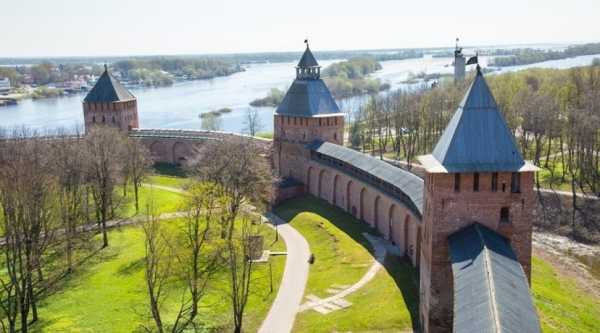
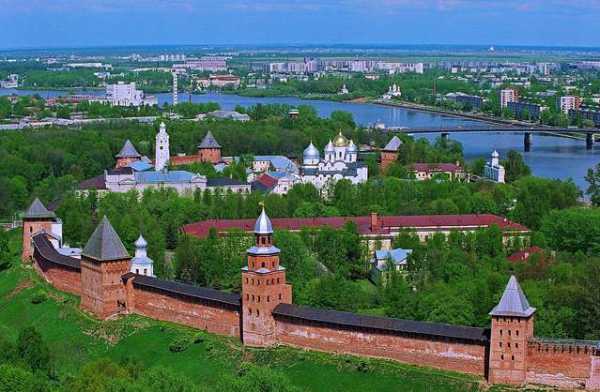
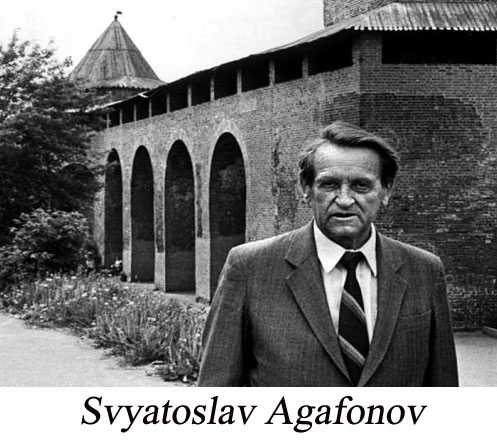 The Kremlin of Nizhny Novgorod (built in the years 1500-1511) was an important military fortification of its time The total perimeter of the walls is 2045 m, its surface is 22,7 ha (compare: the Moscow Kremlin 2250 m and 27,5 respectively). The Kremlin was built with the participation of Russian and Italian craftsmen. The Kremlin was restored in the middle of the XX-th century under the supervision of Svaytoslav Agafonov. At present the towers and the walls of the Kremlin are under the jurisdiction of History and Architecture Museum. The Kremlin of Nizhny Novgorod is the administrative center of the Volga region, of Nizhegorodskaya oblast' and of Nizhny Novgorod itself.
The Kremlin of Nizhny Novgorod (built in the years 1500-1511) was an important military fortification of its time The total perimeter of the walls is 2045 m, its surface is 22,7 ha (compare: the Moscow Kremlin 2250 m and 27,5 respectively). The Kremlin was built with the participation of Russian and Italian craftsmen. The Kremlin was restored in the middle of the XX-th century under the supervision of Svaytoslav Agafonov. At present the towers and the walls of the Kremlin are under the jurisdiction of History and Architecture Museum. The Kremlin of Nizhny Novgorod is the administrative center of the Volga region, of Nizhegorodskaya oblast' and of Nizhny Novgorod itself.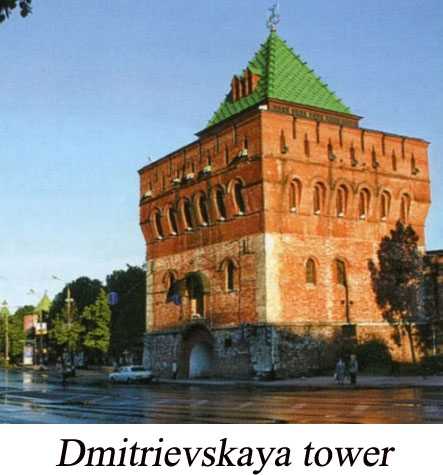 Dmitrievskaya tower was the main entrance to the Kremlin and besides was initially the upland center of defence. The tower got its name from Dmitry Solunsky church. As a reserve of History and Architecture Museum it hosts various exhibitions. In 1993 the image of the founder of Nizhny Novgorod - the Great Prince Yury Vsevolodovich - was installed in the icon niche on the outer part of the tower above the entrance. Kladovaya (Storage) tower was used as armoury, the place where weapons were stored (that's where the name comes from). Now there is a bar in the tower which has the same name "Kladovaya tower". This is the starting point of an excursion around the Kremlin walls (as far as Chasovaya tower). Nikolskaya tower got its name from Verhneposadskaya Nikolskaya church, which stood in Bolshaya Pokrovskaya Street. The tower belonged to military department and was used as a warehouse.
Dmitrievskaya tower was the main entrance to the Kremlin and besides was initially the upland center of defence. The tower got its name from Dmitry Solunsky church. As a reserve of History and Architecture Museum it hosts various exhibitions. In 1993 the image of the founder of Nizhny Novgorod - the Great Prince Yury Vsevolodovich - was installed in the icon niche on the outer part of the tower above the entrance. Kladovaya (Storage) tower was used as armoury, the place where weapons were stored (that's where the name comes from). Now there is a bar in the tower which has the same name "Kladovaya tower". This is the starting point of an excursion around the Kremlin walls (as far as Chasovaya tower). Nikolskaya tower got its name from Verhneposadskaya Nikolskaya church, which stood in Bolshaya Pokrovskaya Street. The tower belonged to military department and was used as a warehouse.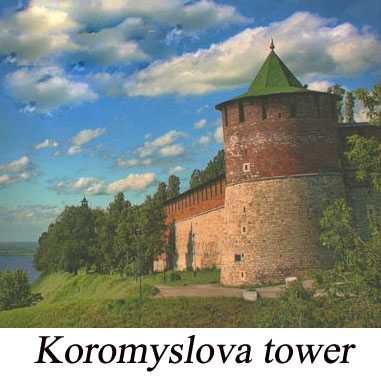 Koromyslova (Yoke) tower. There is a poetic legend about how the tower got its name. This legend is about a girl who killed a lot of enemies using a yoke. She was buried with all honours under the basement of the tower. The other version of how the tower got its name says that the tower together with the adjacent walls resembles a woman with a yoke. Tainitskaya (Secret) tower was called so because it had a secret underground passage which led to the Pochaina River. In 1941-1942 antiaircraft guns were mantled on the upper platform of the tower. Severnaya (North) tower is called so because it is situated to the north of Tainitskaya tower. This tower as well as Chasovaya tower was planned to be reconstructed and used as the residence for VIPs visiting our city (this plan was not realized). During the years of the Great Patriotic War (1941-1945) there was a weapon emplacement of anti-aircraft defence on the upper platform of the tower.
Koromyslova (Yoke) tower. There is a poetic legend about how the tower got its name. This legend is about a girl who killed a lot of enemies using a yoke. She was buried with all honours under the basement of the tower. The other version of how the tower got its name says that the tower together with the adjacent walls resembles a woman with a yoke. Tainitskaya (Secret) tower was called so because it had a secret underground passage which led to the Pochaina River. In 1941-1942 antiaircraft guns were mantled on the upper platform of the tower. Severnaya (North) tower is called so because it is situated to the north of Tainitskaya tower. This tower as well as Chasovaya tower was planned to be reconstructed and used as the residence for VIPs visiting our city (this plan was not realized). During the years of the Great Patriotic War (1941-1945) there was a weapon emplacement of anti-aircraft defence on the upper platform of the tower.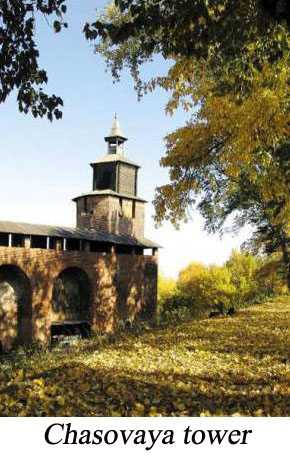 Chasovaya (Clock) tower was called so because it housed the main tower clock. During the years of the Great Patriotic War (1941-1945) there was a weapon emplacement of anti-aircraft defence on the upper platform of the tower. Since 1980 it has been used as a base to provide support for Changing the Guards ceremony at the Eternal Fire on the territory of the Kremlin.
Chasovaya (Clock) tower was called so because it housed the main tower clock. During the years of the Great Patriotic War (1941-1945) there was a weapon emplacement of anti-aircraft defence on the upper platform of the tower. Since 1980 it has been used as a base to provide support for Changing the Guards ceremony at the Eternal Fire on the territory of the Kremlin.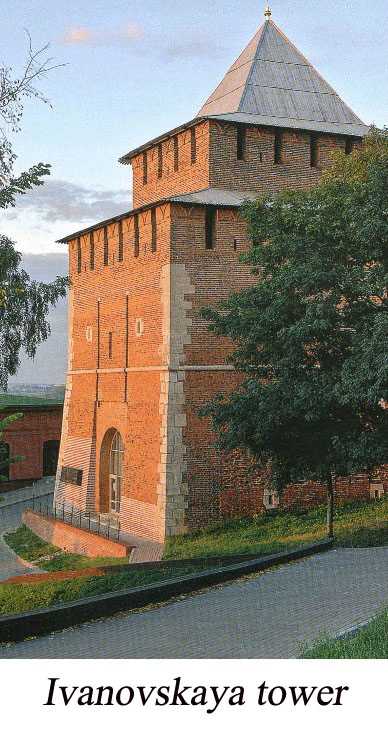 Ivanovskaya tower was the main entrance and the center of the lowland part of the Kremlin. It was called in honour of the near standing Saint John the Baptist Church. This tower became famous after the emergency volunteer corps of Nizhny Novgorod headed by Minin and Pozharsky started their march to set it free from the Polish invaders in 1612. In memory of this historical event a permanent exposition was opened in the tower in 2004. Belaya (White) tower is called so as it was made of white stone. Zachatievskaya tower was destroyed because of landslides. It got its name after the near standing Zachatievsky convent. There is a project of its reconstruction. Borisoglebskaya tower is the copy of the ancient tower dismantled in the years 1785-1795. It got its name after Boris and Gleb Church. Georgievskaya tower was called after St. George. During the repair works in the XVII century the entrance gates were blocked up with brick. During the Soviet years the tower was used as a warehouse. Porokhovaya (Gunpowder) tower was called so as it stored gunpowder in its cellars. It is not used nowadays. A memorial plaque to commemorate the military units formed on the Nizhegorodskaya land during the years of the Great Patriotic War (1941-1945) is mantled on the outer side of the wall connecting it to Dmitrievskaya tower.
Ivanovskaya tower was the main entrance and the center of the lowland part of the Kremlin. It was called in honour of the near standing Saint John the Baptist Church. This tower became famous after the emergency volunteer corps of Nizhny Novgorod headed by Minin and Pozharsky started their march to set it free from the Polish invaders in 1612. In memory of this historical event a permanent exposition was opened in the tower in 2004. Belaya (White) tower is called so as it was made of white stone. Zachatievskaya tower was destroyed because of landslides. It got its name after the near standing Zachatievsky convent. There is a project of its reconstruction. Borisoglebskaya tower is the copy of the ancient tower dismantled in the years 1785-1795. It got its name after Boris and Gleb Church. Georgievskaya tower was called after St. George. During the repair works in the XVII century the entrance gates were blocked up with brick. During the Soviet years the tower was used as a warehouse. Porokhovaya (Gunpowder) tower was called so as it stored gunpowder in its cellars. It is not used nowadays. A memorial plaque to commemorate the military units formed on the Nizhegorodskaya land during the years of the Great Patriotic War (1941-1945) is mantled on the outer side of the wall connecting it to Dmitrievskaya tower.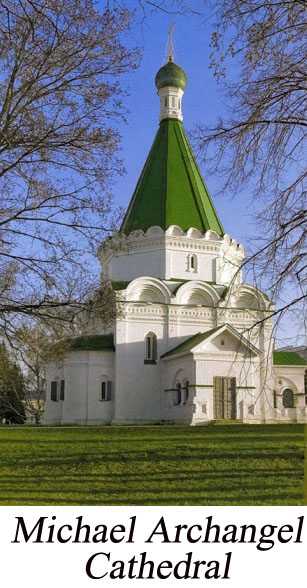 Michael Archangel Cathedral is the most ancient construction on the territory of the Kremlin that has been preserved till nowadays. It's a remarkable specimen of old Russian architecture. It was built in the years 1628-1631 on the place where in 1221 (the year when Nizhny Novgorod was founded) a wooden church in the name of Michael Archangel was founded. There is the Tomb of Kozma Minin - the organized and the leader of Russian people emergency volunteer corps of 1611-1612. Now the Cathedral is a functioning Russian Orthodox church. Administrative Building. Cadet Corps. In 1785 two-stored buildings were constructed in accordance with the project by Ananjin (Rastrelly's disciple). Later they were reconstructed and in 1840 the building got its present look. Here in 1840 in the family of a teacher from Cadet Corp was born a famous Russian pilot P.N. Nesterov.
Michael Archangel Cathedral is the most ancient construction on the territory of the Kremlin that has been preserved till nowadays. It's a remarkable specimen of old Russian architecture. It was built in the years 1628-1631 on the place where in 1221 (the year when Nizhny Novgorod was founded) a wooden church in the name of Michael Archangel was founded. There is the Tomb of Kozma Minin - the organized and the leader of Russian people emergency volunteer corps of 1611-1612. Now the Cathedral is a functioning Russian Orthodox church. Administrative Building. Cadet Corps. In 1785 two-stored buildings were constructed in accordance with the project by Ananjin (Rastrelly's disciple). Later they were reconstructed and in 1840 the building got its present look. Here in 1840 in the family of a teacher from Cadet Corp was born a famous Russian pilot P.N. Nesterov.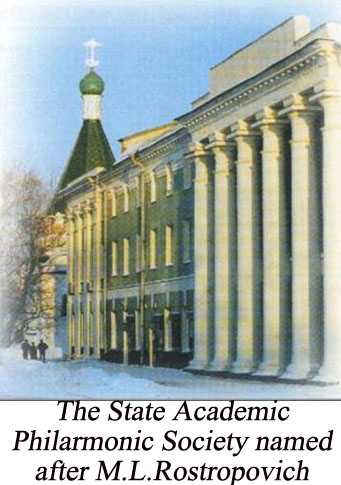 At present the building houses the Legislative Assembly of Nizhegorodskaya oblast', administrative buildings and the State Academic Philharmonic Society named after M.L. Rostropovich. The vice-governor's houses is a splendid specimen of a gala administrative building of the end of the XVIII-th century. It is one of the main constructions forming the administrative complex of the Kremlin. It was built in the years 1786-1788. The house underwent repair works several times; as a result it was partially modified. At present it houses the Arbitrage Court of Nizhegorodskaya oblast'. The building of the Kremlin Police Unite was constructed several times. It housed the City Telephone Exchange. Since 1994 the Federal Treasure Administration in Nizhegorodskaya oblast'. An extension was added to the building. The building of the Arsenal was built in the years 1838-1843. During its entire existence it was used as a storage of ammunition. Since 2003 it holds the State Center of Modern Art. The manage was built in 1841. training of horses and military parades were held here. In the years 1901,1902,1903 and 1904 Maxim Gorky organized here famous New Year's celebrations for poor children. After the Revolution the building was used as a tram depot, later it stored garages and warehouses. A project of its reconstruction has been developed. The garnison barracks were built in the years of their existence they housed military units. The seat of the regional committee of the C.P.S.U. (The Communist Party of the years 1974-1976. It is a specimen of rationalism in Soviet architecture of the 1960-70-s. It imitates the Kremlin Palace of Conventions in Moscow. A present it's the home for the representative office of the president of the Russian Federation in the Volga area and the Administration of Nizhegorodskaya oblast'.
At present the building houses the Legislative Assembly of Nizhegorodskaya oblast', administrative buildings and the State Academic Philharmonic Society named after M.L. Rostropovich. The vice-governor's houses is a splendid specimen of a gala administrative building of the end of the XVIII-th century. It is one of the main constructions forming the administrative complex of the Kremlin. It was built in the years 1786-1788. The house underwent repair works several times; as a result it was partially modified. At present it houses the Arbitrage Court of Nizhegorodskaya oblast'. The building of the Kremlin Police Unite was constructed several times. It housed the City Telephone Exchange. Since 1994 the Federal Treasure Administration in Nizhegorodskaya oblast'. An extension was added to the building. The building of the Arsenal was built in the years 1838-1843. During its entire existence it was used as a storage of ammunition. Since 2003 it holds the State Center of Modern Art. The manage was built in 1841. training of horses and military parades were held here. In the years 1901,1902,1903 and 1904 Maxim Gorky organized here famous New Year's celebrations for poor children. After the Revolution the building was used as a tram depot, later it stored garages and warehouses. A project of its reconstruction has been developed. The garnison barracks were built in the years of their existence they housed military units. The seat of the regional committee of the C.P.S.U. (The Communist Party of the years 1974-1976. It is a specimen of rationalism in Soviet architecture of the 1960-70-s. It imitates the Kremlin Palace of Conventions in Moscow. A present it's the home for the representative office of the president of the Russian Federation in the Volga area and the Administration of Nizhegorodskaya oblast'.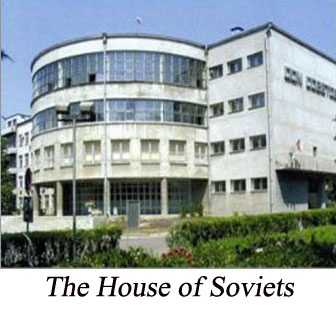 The House of Soviets became one of the first large public buildings constructed under the Soviet regime in our city in the years 1929-1931. When preparing the building site a decision was made to demolish the Saviour Transfiguration Cathedral as well as the guardhouse at the military governor's house. This building is a typical specimen of constructivism in architecture: it consist of two intersecting four-storeyed buildings a cylindrical "cockpit", due to which the building resembles an airplane. Since the time when it was built it has been the seat of the municipal authorities. The palace of the military governor was built in 1841. After the revolution it housed the headquarters of the Kommunist party and the Komsomol. Since 1991 the palace is occupied by the Nizhegorodsky State arts Museum which has a richest collection of painting, graphic arts and sculpture.
The House of Soviets became one of the first large public buildings constructed under the Soviet regime in our city in the years 1929-1931. When preparing the building site a decision was made to demolish the Saviour Transfiguration Cathedral as well as the guardhouse at the military governor's house. This building is a typical specimen of constructivism in architecture: it consist of two intersecting four-storeyed buildings a cylindrical "cockpit", due to which the building resembles an airplane. Since the time when it was built it has been the seat of the municipal authorities. The palace of the military governor was built in 1841. After the revolution it housed the headquarters of the Kommunist party and the Komsomol. Since 1991 the palace is occupied by the Nizhegorodsky State arts Museum which has a richest collection of painting, graphic arts and sculpture.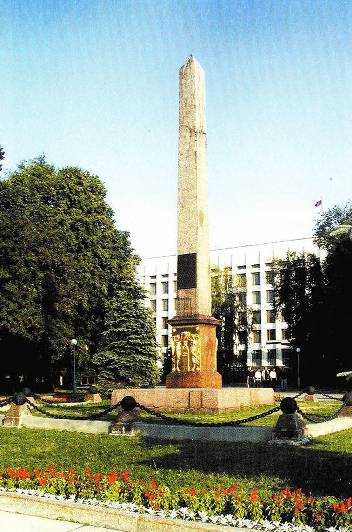 The obelisk in honour of Kozma Minin and Dmitry Pozharsky is the oldest monument in Nizhny Novgorod which was built to commemorate the organizers of the Russian people emergency volunteer corps of 1612. The monument was erected in 1828. The architect is A.I. Melnikov, the sculptor is A.P. Martos (the author of the monument to Minin and Pozharsky on Red Square). The copy of the monument was established in Nizhny Novgorod in 2004 in Narodnogo Edinstva square. The memorial complex dedicated to Gorkovites who heroically perished during the Great Patriotic War (1941-1945) was opened in 1965. The complex consists of granite walls with inscriptions, a tall stele with a bas-relief and names of perished Nizhny Novgorod citizens on it, and also a granite slab with the Eternal Fire. On the 9-th of May, 1970 a T-34 tank was added to the complex.
The obelisk in honour of Kozma Minin and Dmitry Pozharsky is the oldest monument in Nizhny Novgorod which was built to commemorate the organizers of the Russian people emergency volunteer corps of 1612. The monument was erected in 1828. The architect is A.I. Melnikov, the sculptor is A.P. Martos (the author of the monument to Minin and Pozharsky on Red Square). The copy of the monument was established in Nizhny Novgorod in 2004 in Narodnogo Edinstva square. The memorial complex dedicated to Gorkovites who heroically perished during the Great Patriotic War (1941-1945) was opened in 1965. The complex consists of granite walls with inscriptions, a tall stele with a bas-relief and names of perished Nizhny Novgorod citizens on it, and also a granite slab with the Eternal Fire. On the 9-th of May, 1970 a T-34 tank was added to the complex.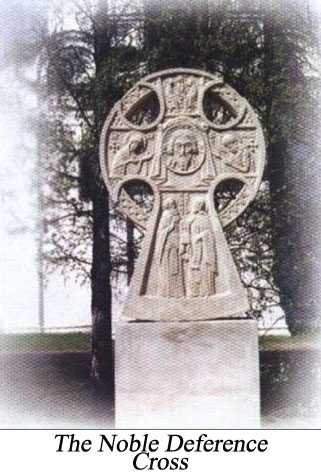 The memorial "Gorkovites supporting the Army" was opened in the 1975 as a constantly working exhibition of ammunition produced in Gorky during the World War II: the famous tank T-34 built in Sormovo, armoured cars, guns, self-propelled guns, mortars, the legendary "Katusha" and Red Star planes. An obelisk with a figure of George the Victory Bearer, horse-mounted and striking the Serpent, as a symbol of the victories of Russian army was established in 1985. The Noble Deference Cross near the House of Soviets was inaugurated on the Day of May, 1994, on the Day of Slavonic Character and culture. It is the day of the memory of the first Slavonic teachers, Saint Apostles Cirill and Mephodiy. The monument to the founder of Nizhny Novgorod, Prince Georgiy Vsevolodovich, and his spiritual mentor Saint Simon, the first bishop of Vladimir and Suzdal (sculptor V. Purikhov) was opened on February, 26, 2008 within the celebration of the 500-th anniversary of Nizhny Novgorod Kremlin. At present a big project of a new House of Government of Nizhny Novgorod region has been launched. In is designed as a complex including old, reconstructed buildings on the territory of the Kremlin and the new edifice.
The memorial "Gorkovites supporting the Army" was opened in the 1975 as a constantly working exhibition of ammunition produced in Gorky during the World War II: the famous tank T-34 built in Sormovo, armoured cars, guns, self-propelled guns, mortars, the legendary "Katusha" and Red Star planes. An obelisk with a figure of George the Victory Bearer, horse-mounted and striking the Serpent, as a symbol of the victories of Russian army was established in 1985. The Noble Deference Cross near the House of Soviets was inaugurated on the Day of May, 1994, on the Day of Slavonic Character and culture. It is the day of the memory of the first Slavonic teachers, Saint Apostles Cirill and Mephodiy. The monument to the founder of Nizhny Novgorod, Prince Georgiy Vsevolodovich, and his spiritual mentor Saint Simon, the first bishop of Vladimir and Suzdal (sculptor V. Purikhov) was opened on February, 26, 2008 within the celebration of the 500-th anniversary of Nizhny Novgorod Kremlin. At present a big project of a new House of Government of Nizhny Novgorod region has been launched. In is designed as a complex including old, reconstructed buildings on the territory of the Kremlin and the new edifice.